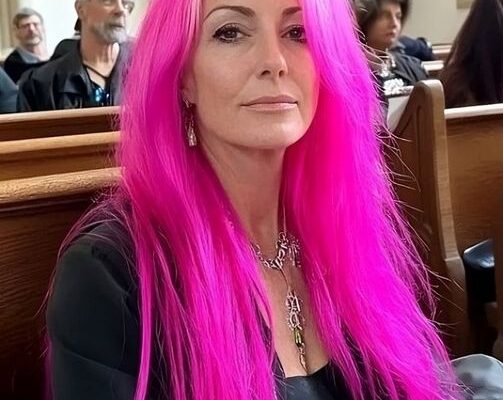This past Sunday was supposed to be an ordinary day at church—a time for quiet reflection, connection, and reverence. But as I settled into the pew, something caught my attention that completely threw me off balance: a woman sitting near the front with bright pink hair. I’ll admit, I was genuinely taken aback.

In a world that increasingly values and encourages self-expression, I understand that everyone has their own style. However, I couldn’t shake the feeling that this particular style seemed out of place in a sacred setting. In my mind, church is a place that embodies modesty and respect, not necessarily a stage for bold fashion statements. As the preacher began his sermon, I found it difficult to concentrate; my thoughts kept drifting back to that striking neon pink hair.
Why Do We Hold Certain Expectations in Sacred Spaces?
I grew up during a time when dressing conservatively for church was the norm. Muted tones, understated outfits, and a general simplicity in our appearance were seen as ways to show respect. For me, church attire has always represented an extension of the reverence we hold for the space itself—a place to quiet the mind and focus on things beyond ourselves. So, I found myself wondering: Is it wrong to feel that vibrant pink hair might not be appropriate for a place of worship?
As I mulled over this question, it struck me that many of us carry unspoken expectations about how we and others should behave or dress in particular environments. Sacred spaces like churches often bring these expectations into sharper focus, as they are set apart from our everyday lives. But with the changing times and evolving ideas about self-expression, do these old standards still hold weight?
An Unexpected Encounter and a Surprising Response
After the service ended, I noticed the woman with the pink hair standing outside the church, chatting with a group of people. I hesitated, unsure whether I should approach her. Part of me didn’t want to create any tension, but I also felt like I needed to express my perspective. Gathering my courage, I walked over and politely said, “Excuse me, I couldn’t help but notice your hair. I just wanted to share my thoughts—bright colors like that might not feel appropriate for church.”
I half-expected her to be taken aback or to offer an explanation. Instead, she responded without missing a beat: “Well, I don’t think it’s any of your business,” she replied, a small, tight smile on her face. “I come to church to pray, not to be judged on my appearance.”
Her bluntness left me stunned. My intention hadn’t been to make her feel unwelcome, nor did I want to start an argument. I simply wanted to express how I felt about respect for the church environment. But her response got me thinking—did I cross a line? Was I wrong to voice my opinion?
Challenging Our Own Beliefs About Respect and Tradition
This experience left me questioning my own beliefs. I’ve always held certain standards about how we should present ourselves in spaces like churches. It’s not about denying anyone’s individuality; rather, it’s about honoring a space that is deeply meaningful for many. I see church as a place for humility, introspection, and connection, not for drawing attention with flashy hairstyles or bold fashion choices.

Yet, in today’s world, perhaps my perspective comes across as old-fashioned. As society becomes more relaxed and individualistic, maybe these longstanding ideas about respect and tradition are starting to shift. Maybe I need to reevaluate my views and recognize that self-expression is simply evolving.
But even as I consider this, I can’t help but feel that something valuable is being lost. Aren’t sacred spaces meant to be treated differently from other environments? Shouldn’t we reserve a certain decorum for places that symbolize something larger than ourselves?
The Cultural Evolution of Dress Codes in Church
The idea of dressing modestly for church has been ingrained in many cultures for centuries. Whether through formal attire or modest clothing, dressing up for church was traditionally seen as a way to show respect. However, with changing social norms, churches in many parts of the world have adopted a more casual approach, welcoming people to come as they are.
In the past, long hair for women and short hair for men were visual markers of gender roles and respectability. Today, though, these conventions have softened, allowing room for greater flexibility and personal expression. Hairstyles, colors, and fashion choices that were once considered radical or inappropriate are now widely accepted—even in places like churches. But does that mean all traditions should be discarded? Or is there a way to find a balance that respects both individual freedom and the sanctity of sacred spaces?
Is It Time to Embrace a New Perspective?

This experience has challenged me to think differently. While I initially felt justified in my reaction, I’ve come to realize that church should be a place where everyone feels welcome, regardless of appearance. If someone feels comfortable expressing themselves through bright pink hair, perhaps that’s something we should embrace rather than question. After all, what truly matters is the intention behind one’s presence in church, not the color of their hair.
In the end, the essence of church lies in its message and purpose. It’s a place for prayer, reflection, and connection with others. If we focus too much on external appearances, we risk missing the bigger picture. Maybe it’s time for us to let go of rigid expectations and open our hearts to a broader understanding of respect—one that goes beyond clothing or hair color.
Finding Common Ground: Tradition and Modernity
Finding a balance between tradition and modernity isn’t easy, especially when it comes to deeply held beliefs. However, I believe it’s possible to honor the essence of sacred spaces while also welcoming personal expression. Perhaps this means we continue to value respect, not just through appearance, but through our actions and how we treat one another.

In the grand scheme of things, pink hair or a unique fashion choice may not matter nearly as much as the respect we show for one another’s beliefs, experiences, and journeys. If churches can embrace this more inclusive perspective, perhaps they’ll find new ways to connect with younger generations who seek meaning but also value self-expression.
Conclusion: A Lesson in Acceptance
Reflecting on this experience, I realize that the way we view respect and reverence is evolving. While I may still feel that certain traditional values are worth preserving, I also see the importance of accepting change and making room for diverse expressions of faith. The next time I see something in church that challenges my expectations, I hope to remember this experience and approach it with an open heart and a spirit of understanding.
Whether you share my feelings or believe I was wrong, I’d love to hear your thoughts. Do you think there’s still a place for traditional standards in today’s churches, or should we embrace a more open, individual-focused mindset? Let’s keep the conversation going and explore what respect and reverence mean in our modern world.



